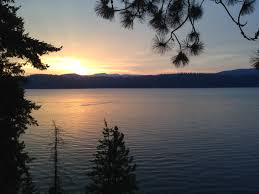The October, 2020 annual survey of Coeur d’Alene Lake chinook salmon redds showed a strong spawning run, with the second highest count on record.
Idaho Fish and Game biologists counted 213 redds in the Coeur d’Alene River, 27 redds in the South Fork Coeur d’Alene River and 9 redds in the St Joe River for a total of 249 redds.
This was the second highest count on record and the first time redds were observed in the St. Joe River since 2015 when 15 redds were found.
Coincidentally, 2015 was the highest count on record with a total of 303 redds across all three rivers.
“The high redd count in 2020 is encouraging and demonstrates that chinook salmon have rebounded following several years of lower spawner abundance,” said IDFG fisheries biologists Carlos Camacho in an informational posting on the IDFG website.
“For comparison, there were only 28 redds counted in 2018 and 61 redds counted in 2019. Numerous environmental conditions can influence the chinook salmon population in Coeur d’Alene Lake resulting in abundances that can be quite variable year to year,” he said.
“However, 2020 was certainly a good year for the chinook salmon population and provides optimism for the future. Keep in mind that it will be 3-5 years before the eggs put into the gravel in 2020 will turn into that heart-pounding rush of a 10-20 pound chinook salmon ripping line from your reel.”
Since 1990, IDFG has conducted annual surveys to count the number of redds (nests salmon dig to deposit eggs) from Coeur d’Alene Lake chinook salmon.
In early October after chinook are done spawning, fisheries biologists walk and float 11 miles of the Coeur d’Alene River, 6 miles of the South Fork Coeur d’Alene River, and 14 miles of the St. Joe River looking for the defining characteristics of a salmon redd.
Each female salmon uses her tail to excavate rocks (up to the size of a softball), creating a pit where her eggs are deposited and fertilized by the male. The female then covers her fertilized eggs with rocks for protection. This process occurs several times and results in a 6-10 foot circular area that forms a 1-2 foot deep pit immediately upstream of a large pile of rocks.
It is this final rock structure that is counted by biologists to determine how many females successfully spawned. Eggs will incubate over the winter, hatch in the spring, and eventually the offspring produced will migrate downstream, creating the next generation of chinook salmon in Coeur d’Alene Lake, said Camacho.
In addition to counting redds, biologists collected information on length, age, sex, and spawning success from a sample of the dead salmon on the spawning grounds.
When fishing for chinook salmon in the Panhandle Region, a fish must be at least 20 inches long to be kept and the daily bag limit is two fish. In addition, chinook salmon look similar to kokanee when small in size. The best way to distinguish between the two species is to look at the color inside of the mouth. A chinook salmon’s mouth will be black in color and a kokanee will have a pale colored mouth.
The Northwest Power and Conservation Council’s Coeur d’Alene Subbasin Plan says: “In 1982, Chinook salmon were first introduced into Coeur d’ Alene Lake as a biological control to manage an increasing kokanee population. Chinook salmon abundance is managed through wild escapement in the Coeur d’ Alene and St. Joe rivers as well as some supplementation with hatchery fish in the north end of the lake. The management plan for Chinook salmon calls for a total annual stocking level of 70,000 Chinook smolts with wild (approximately 40,000) and hatchery (approximately 30,000) combined. Chinook abundance is controlled to maintain kokanee at a level that maintains a yield fishery for 10-11 inch kokanee and a limited trophy fishery for Chinook salmon in the 3-18 pound range (IDFG Fisheries Management Plan 2001-2006). Chinook salmon provide an important component of the sport fishery of Coeur d’ Alene Lake, but may have some detrimental effects on the native sport fishes through direct predation on juvenile westslope cutthroat or bull trout.”

